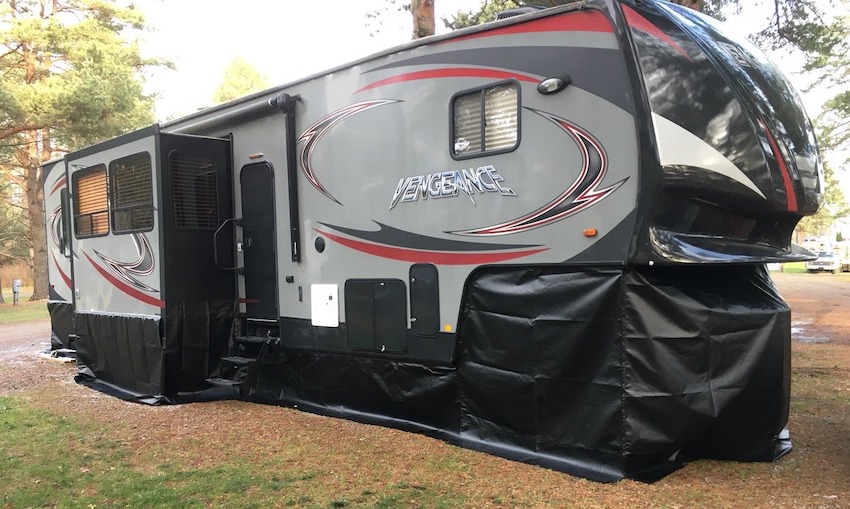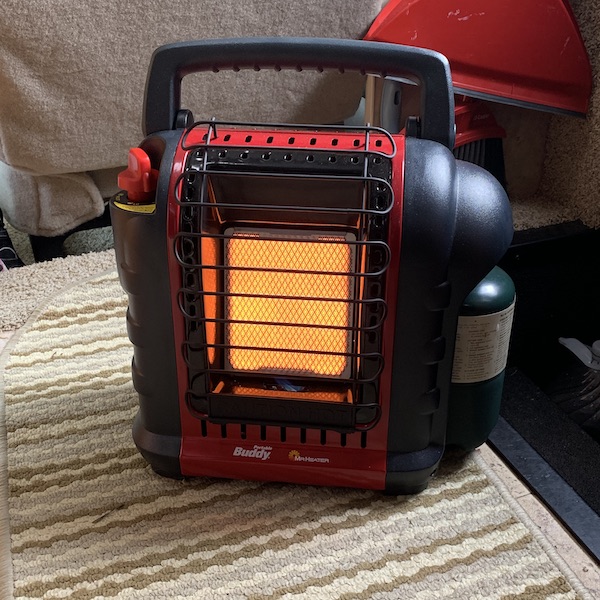Thanks for your support! If you make a purchase using our links in this article, we may make a commission. And, as an Amazon Associate, I earn from qualifying purchases. See the full disclosure here.
In winter, keeping yourself warm in a camper is very important. It can also be pretty tricky until you get the hang of it. That said, there are many creative ways to warm your camper that you may or may not be considering. Stay tuned for the 10 best ways to heat a camper in the winter.
In this piece, we’ll discuss ten of the very best and creative ways to heat a camper during the coldest parts of the year. They are:
- Use a Portable Heater
- Solar Power
- Use an RV Woodstove
- Generator
- Battery Power for Heat
- Add Extra Interior Insulation
- Catalytic Heater
- Cover Your Vents
- Use a Skirt ***Scroll down and Check out the Video we made about our RV Skirting!
- Heavy Blankets, Sleeping Bags, and Clothing
10 Best Ways to Heat A Camper in Winter
1. Use a Portable Heater
Right behind blankets and generally dressing for the cold, portable heaters are among the most popular methods for heating campers. These heaters are widely available for purchase and come in various models and rely on several different power sources.
Electric portable heaters are perhaps the most preferred with many RVers. They are inexpensive and work rather well at heating small spaces like campers. That said, the newest models are also very much energy efficient.
Battery-powered portable heaters are also an excellent option. They are often smaller than other portable heaters and take less energy to run. They also throw out a bit less heat than electric heaters. However, in smaller campers, or using more than one heater in larger campers, they work just fine. Portable heaters work great in bathrooms and bedrooms as well.
Portable propane heaters are yet another popular heating option for campers in the winter. Oftentimes larger and more powerful than electric or portable heaters, propane heaters will easily heat your camper. It is important to note that they also cost more to operate for long periods of time. There is an additional risk of carbon monoxide poisoning that comes along with them.
We use our Mr. Buddy portable heater on the lowest setting and it lasts about 5 hours and keeps our 24′ Class C RV warm over night. Just remember you have to ventilate when using a propane heater.
2. Solar Power
Solar power is useful for a variety of applications when it comes to campers and RVs. Heating a camper in the winter is no exception to this rule. In fact, using solar power to heat your camper during the winter is a brilliant move as it’s practically free (minus the initial set-up costs).
Besides using solar panels to power electric heaters in your camper, there are more rudimentary ways to harness the power of solar to heat campers. One example is that certain panels draw enough sun to the top of your camper that the photons help raise the temperature inside. Another way to heat a camper with solar is by building a solar heating window box.
3. Use an RV Woodstove
Believe it or not, a good old-fashioned wood stove is an excellent way to heat a camper. While this may not be the first method that comes to mind, they are more than worthy of your consideration.
In today’s market, woodstoves specifically designed for heating campers and RVs are plenty. They are built in such a manner that the smoke from the fire is channeled through a large pipe and out of the window. So, no need to count this method out do to fear of a smoky environment inside your camper.
There are also electric and other portable camper heaters designed to resemble woodstoves for aesthetic value. If you prefer electric, batteries, or propane fuel sources, a non-traditional “woodstove” is still a real option. One of the best things about woodstoves for heating campers is the comfy and cozy atmosphere they create.
4. Generator
Alternatively to solar panels, battery banks, and propane tanks, generators are always a good choice. When it comes to keeping campers warm in the coldest parts of the year, a generator can help a lot.
Without an electricity hook-up, by choice or not, your camper is temporarily dead in the water. With a generator, you are able to provide instant power to your camper as long as you keep fuel in the generator. This can go on indefinitely, most definitely through the winter with ease.
Gas generators are extremely popular with RVers due to how easy and convenient they are to use. More or less, you hook them up to the main gas and allow them to feed on that fuel source and power the entire rig. In other cases, portable gas, diesel, and alternatively-powered generators are also available.
All things considered, the worst aspect of using generators to heat a camper is the noise-level. Many generators, especially the gas ones, are pretty loud. That said, many super-quiet running generators are also available on the market.
5. Battery Power for Heat
Another widely popular method of powering heat sources for campers is batteries. That said, batteries come in many shapes and sizes, as do camper heaters. Campers also sometimes include a battery bank known as “house batteries” which are also useful for powering heaters during the winter.
Batteries range from car batteries and boat batteries and solar-charged batteries to disposable AA, AAA, C-type, and D-type. Depending on the sort of heater you plan on using, the batteries required for powering it will vary. Make sure you know exactly what sort of batteries are needed before purchasing a heater for your camper.
When it comes to solar power, keep in mind that a 200 amp to 600 amp service is ample enough supply to power camper heaters day in and day out. However, if you plan to power more than just heaters and basic appliances, more juice may be needed.
6. Add Extra Interior Insulation
One out-of-the-box way to keep your camper warm during the winter (and any time of year for that matter) is adding extra insulation. I know what you’re thinking… “that sounds like a pretty big pain in the butt.” But, you couldn’t be more incorrect. Adding extra insulation to campers is quick and easy.
Start by checking around windows and doors for cracks or holes that may allow cold air to seep or blow through. This can easily be insulated with weather strips, rubber, plastic sheets, insulation strips, and more.
In addition, adding curtains or canvas tarps to hang over doorways and windows (from the inside) helps a lot too. With a heavy-duty material hanging over the windows and doors more heat is trapped inside and less cold is allowed inside as well.
7. Catalytic Heater
When it comes to heating RVs and campers during the colder months, few options work better than catalytic heaters. Keep in mind, however, that catalytic heaters also require a bit more fuel and energy to work. But, there is no denying their ability to heat an entire RV or camper with relative ease compared to other heating options.
More or less, these heaters are basic furnaces that run on propane. In addition, they sometimes push out and circulate the warm air through the camper via a blower powered by electricity (or batteries).
Most catalytic heaters come with low, medium, and high settings, allowing you a great deal of temperature control. They are ideal for setting on low and leaving to run allow winter as well as they require very little propane and electricity (in fact, some models require zero electricity).
8. Cover Your Vents
Vents in the floor and roof of campers and RVs are another of the main sources of cold each winter. Simply covering them over will help reduce the amount of cold air getting into your camper, keeping it warmer by a general rule. Many RVs and campers may include vent covers, though many do not.
Covering vents for the winter is genuinely an easy task. Some snap on, others require the use of a hand-drill. At any rate, homemade vent covers are just as useful and can be made of practically anything. For example, styrofoam, painter’s tape, reflective tape, even some old pair of pants or a sweater, can be used for covering vents and blocking cold air from entering the camper altogether.
9. Skirt Your RV or Camper

Skirting your RV or camper is a great way to keep the underside of your RV warmer during the cold winter months. Since many RV underbellies aren’t insulated very well a skirt may be a perfect solution.
An RV skirt protects the underside of the RV and all of the water tanks and pipes underneath.
One little known fact is that an RV skirt can keep your RV warm in the winter but it can also keep your RV cool in the summer too!
The very best RV skirting you can buy is AirSkirts. That’s what we purchased and we love it! Check out our video below to see the temperature test we ran that proves that AirSkirts keep your RV warmer for longer in cold temps!
10. Heavy Blankets, Sleeping Bags, and Clothing
To keep yourself warm and cozy in your camper, heavy blankets, and sleeping bags are a great idea. Warm clothing is also smart. Both clothing and blankets will reduce your overall heating costs as well as keep you comfortable.
Heavy blankets and comforters make a huge difference, especially while you’re sleeping in a camper during winter. During the warmer seasons, simply pack them away. Sleeping bags are equally helpful during the coldest parts of the year for staying warm in a camper. Often, sleeping bags are better insulated than any other types of blankets.
Furthermore, taking care of how you dress goes a long way during the colder months as well. Wearing sweaters, long sleeve shirts, and jackets inside the camper during wintertime will also keep you warm and cut back on heating costs as well.
A Final Word About Heating Campers
Keeping your camper or RV heated properly in the winter can be quite the challenge. However, it doesn’t really have to be. Hopefully, our list of 10 creative ways to heat a camper has given you a few ideas to try out this winter.
Do you know a creative way to heat a camper or RV that wasn’t mentioned on our list? Feel free to share with our audience in the comments section below, we’d love to hear from you!
Good luck heating your camper this coming cold season!




I put up quilted bedspreads in areas I had noticed heat loss such as the front door. Made a new headboard for the bed made out of 4×8 insulation that was covered with a fabric of my choosing. Skirted the RV with metal siding we already had on the property. That made all of the difference. Haven’t had any pipe freezing since we put up skirting.
We save our propane by using our electric heater at night to heat the bathroom and bedroom by shutting the door to that area. Then, in the morning, we move it back into the living area and that heats up quickly.
Great idea Kim,
Thanks for sharing!
Mike
Exactly what we do.
It seems in our RV, the Duct work that leads to the Living Room has probably collapsed and no longer works. And there is No way to fix this, without digging up the floor!
Another consideration which we use extensively is our A/C heat pumps. They work great, as long as the outside temp is above 40 degrees.
But, the common electric floor heaters work the best!
Any and all are great ideas for added heat in your camper BUT you still need to run your furnace to keep heat going into the underbelly of an enclosed camper. The furnace has a separate duct that runs into the underbelly to put some heat into it and help to keep your pipes from freezing and also to help to keep your tanks (black and gray/s) from freezing. Skirting helps but if you are in really cold temps (below freezing for several days or more) one should also have some type of extra heat going into the skirted area under your unit. Rodo
Hi Rondo,
Not all campers have a duct that heats the underbelly but this is still a very good point.
Thanks for sharing!
Mike
Funny you mention that about the furnace.
We took a trip a few winters ago to Oklahoma and it would happen to be one of the coldest trips we took.
Went to the WINSTAR Casino, to their excellent RV Park. CHEAP! Found out the water was frozen and ended up leaving to go to a motel. Of course the next morning everything was FROZEN! We were lucky to find a RV park close by that had running water and hooked up there.
Thank Goodness for the Basement Heat, or we probably would have never thawed out! That took about 1 hour from the time we hooked up water to get everthing working again in the RV.
Anytime we go out in cold weather now, I carry 2 electric insulated Water Hoses, with me. A 25 ft. and 50 ft.
Anyway, just my 2 cents worth!